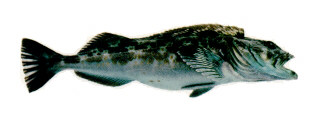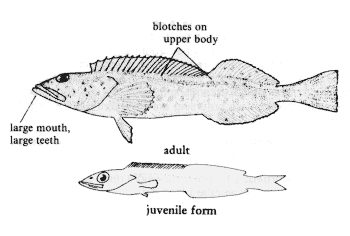Starting Monday, November 5, the Aloha Spirit will resume a weekly Ling Cod Special run. Departing from Channel Islands Sportfishing at 5am, the Aloha Spirit with head out to their favorite fishing grounds. Schedule and reservations can be found here.
Southern California lingcod don’t grow as large as in Alaska. But thanks to seasonal closures and restrictive bag and size limits, the population appears healthy in this Pacific region. Two-fish daily limits are not unusual, and lings weighing in excess of 25 pounds are fairly common.


Family: Hexagrammidae (Greenlings)
Genus and Species: Ophiodon elongatus
Description: The body of the lingcod is elongate, tapering and only slightly compressed. The head is elongate and conical, the mouth is large with numerous large teeth. Lingcod are generally dark brown with lots of spots and blotches on the upper part of the body, but come in a variety of colors ranging from blue green to red brown.
Range: Lingcod occur between Point San Carlos, Baja California, and Kodiak Island, Alaska. They are not abundant south of Point Conception except in a few localities. They live at or near the bottom, generally in close association with rocky areas and kelp beds, especially where there is a strong tidal movement. They occur most abundantly at depths ranging to about 350 feet, but will often go into deeper water and have been caught as deep as 2,700 feet off southern California.
Natural History: Young lingcod feed primarily upon shrimp and other crustaceans until they are big enough to eat fish. Once started on fishes, it seems that any kind coming within reach is fair game. Male and female lingcod first mature when they are 3 years of age and about 23 inches in total length. Nearly all are mature at age 4 when they are nearly 26 inches long. Spawning usually takes place from December through March. The eggs are large (0.17 inch in diameter) and adhesive, sticking in large masses to rocky crevasses, generally on subtidal reefs. The male lingcod guards the eggs after fertilization until they hatch. A female 30 inches long may lay approximately 60,000 eggs; whereas, a 45 inch female may lay more than 500,000 in a single season.
Fishing Information: Lingcod are easily caught on standard rockfish rigs using anchovies or squid pieces. Larger baits such as live squid, mackerel or even small rockfishes often produce catches of very large lingcods. Large chromeplated metal jigs, large lead-head and rubber jigs, and lead-filled pipe jigs are also favorites of avid lingcod anglers. When sportfishing, live bait is more effective than dead bait and dead bait usually more than metal jigs. Whatever the bait, it seems more effective if jigged or bounced up and down along the bottom. Care should be taken when unhooking one of these toothy beasts. The lingcods teeth, as well as the gillrakers, are extremely sharp and can cause serious injury to the fingers of careless anglers. Unless you are wearing heavy gloves, NEVER put your fingers into the mouth or gill chamber of a lingcod. The safest way to pick up a lingcod is to place the thumb and first finger of one hand in the eye sockets and grab the tail with the other hand.
Other Common Names: ling, greenlinger, slinky linky, buffalo cod, cultus cod.
Largest Recorded: 56 pounds (California).
Habitat: Deep Rocky Environment




